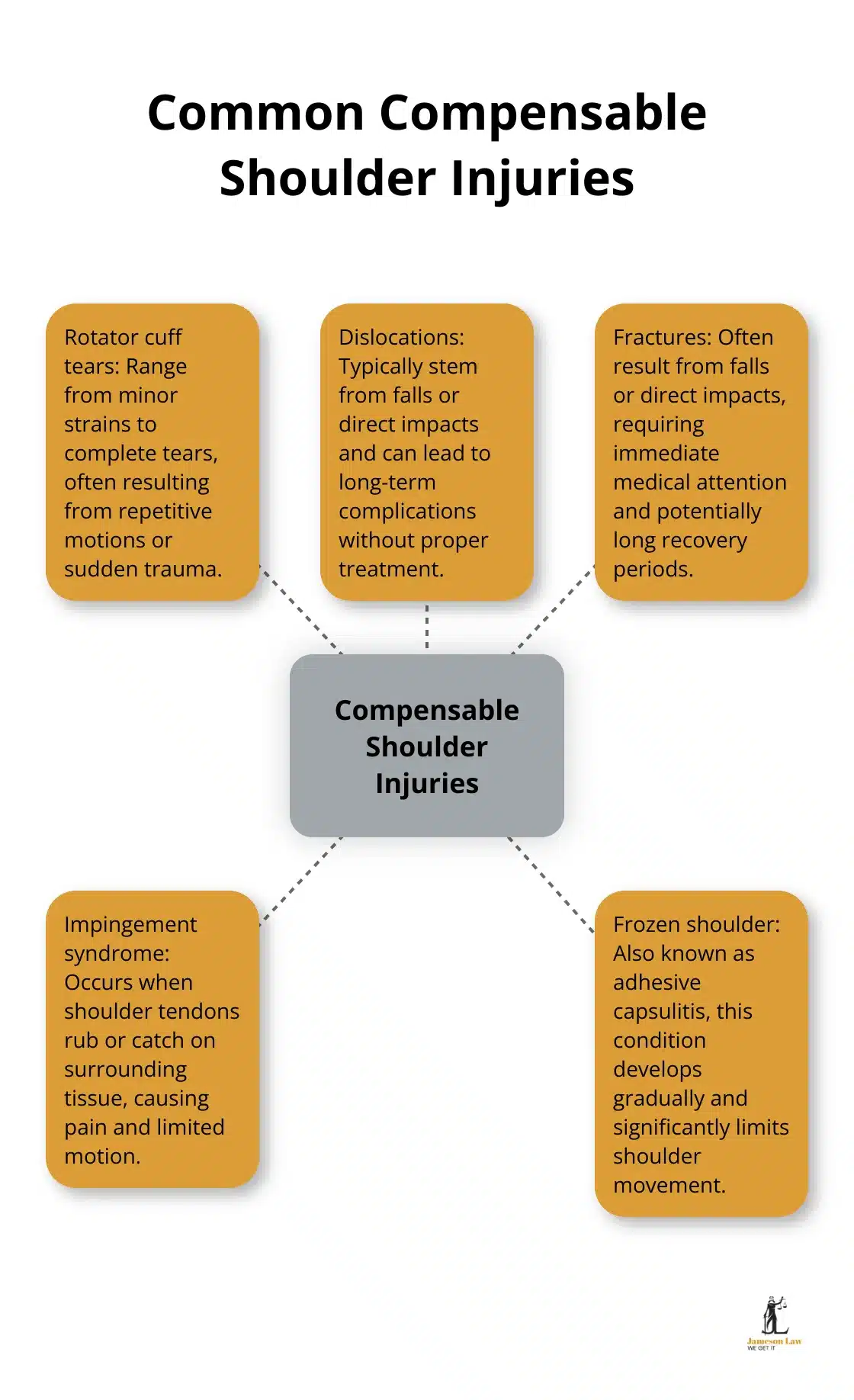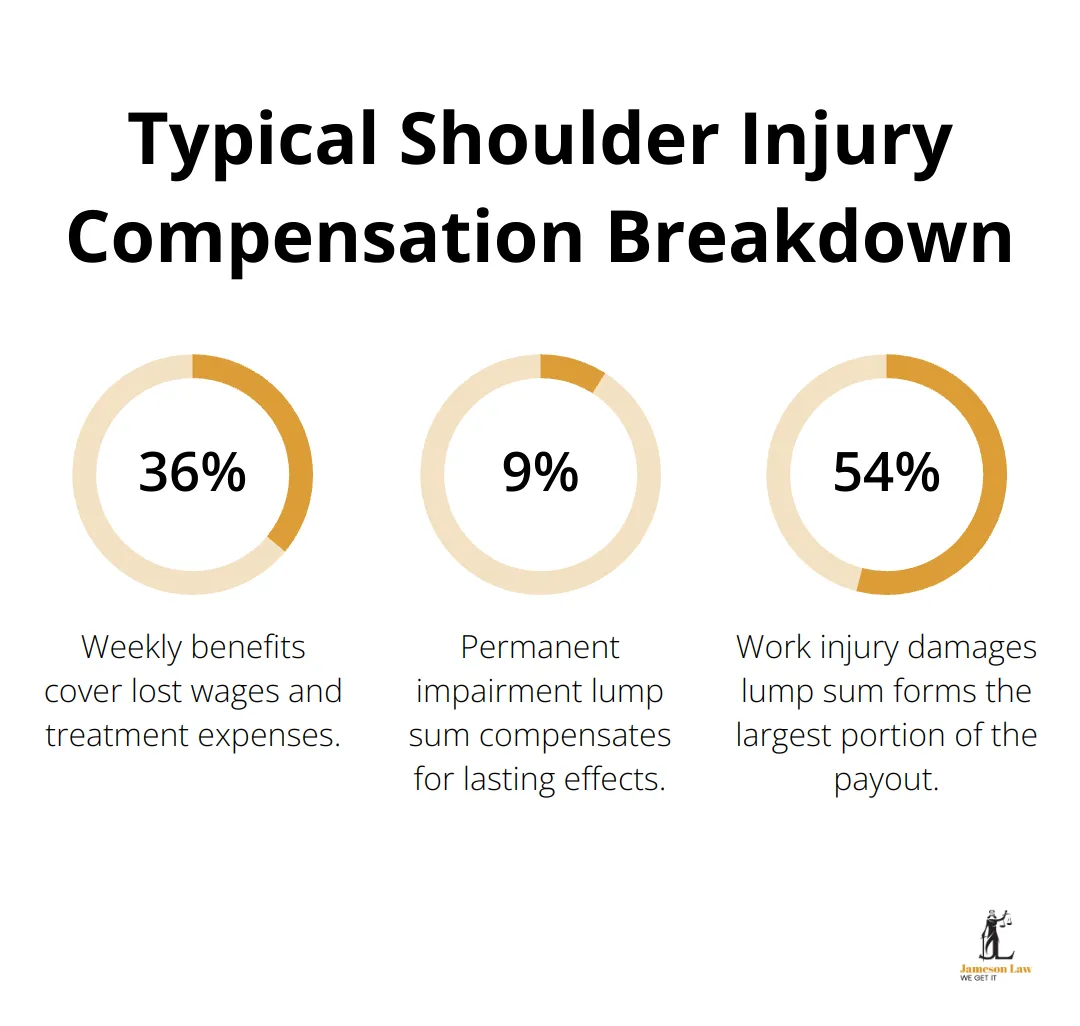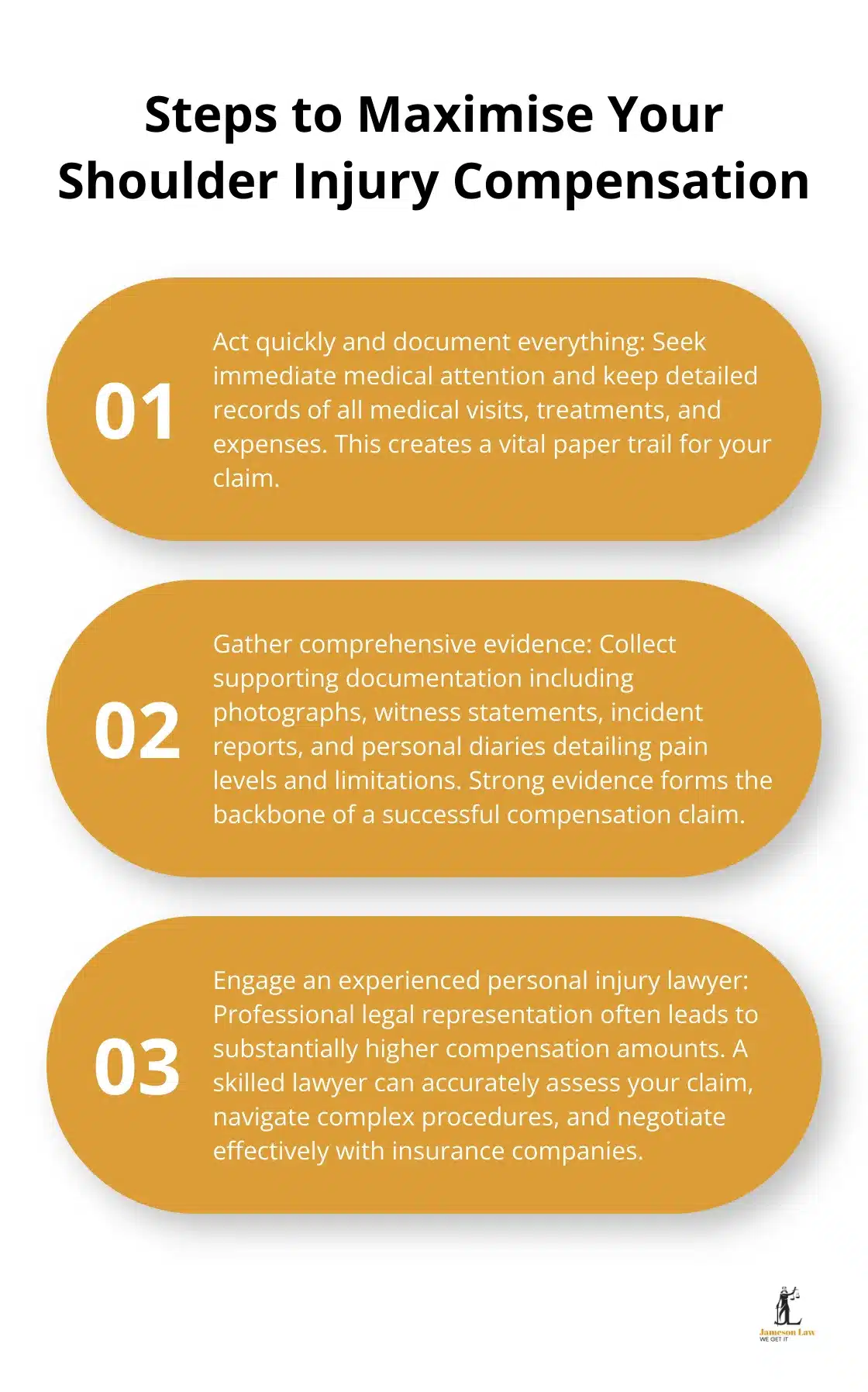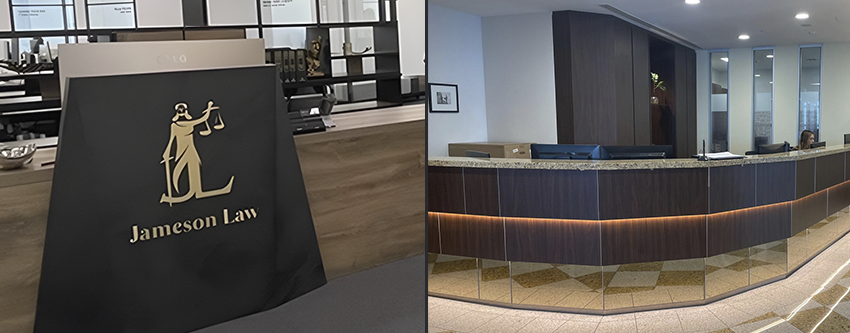Shoulder injuries can be life-altering, affecting your ability to work and enjoy daily activities. In Australia, compensation for these injuries varies widely based on several factors.
At Jameson Law, we’ve seen firsthand how proper legal guidance can significantly impact shoulder injury compensation payouts in Australia. This guide will walk you through the essentials of claiming compensation and maximising your payout.
What Injuries Qualify for Shoulder Compensation?
Common Compensable Shoulder Injuries
Shoulder injuries can significantly impact your ability to work and enjoy daily life. In Australia, various types of shoulder injuries qualify for compensation under the law. These include rotator cuff tears, dislocations, fractures, and impingement syndrome.
Rotator cuff injuries top the list of frequent shoulder injuries. These range from minor strains to complete tears, often resulting from repetitive motions or sudden trauma.
Shoulder dislocations and fractures also commonly feature in compensation claims. These injuries typically stem from falls or direct impacts and can lead to long-term complications without proper treatment.
Frozen shoulder (also known as adhesive capsulitis) is another condition that may qualify for compensation. This painful condition can develop gradually and significantly limit shoulder movement, often affecting a person’s ability to perform work duties.

Factors Influencing Compensation Amounts
Several factors determine the amount of compensation you may receive for a shoulder injury:
- Injury Severity: A minor strain might result in a smaller payout compared to a severe tear requiring surgery.
- Age and Occupation: Younger workers or those in physically demanding jobs may receive higher payouts due to the potential long-term impact on their earning capacity.
- Circumstances of the Injury: Injuries resulting from clear employer negligence often lead to higher compensation. For example, if your employer failed to provide proper safety equipment or training, this could strengthen your claim.
Workers’ Compensation and Public Liability Claims
In Australia, shoulder injuries often fall under workers’ compensation schemes. If you’ve sustained a shoulder injury at work, you may qualify for benefits including medical expenses, lost wages, and rehabilitation costs.
Public liability claims apply when shoulder injuries occur in public spaces due to negligence. For instance, if you slip and fall in a shopping centre due to a wet floor with no warning signs, you might have grounds for a public liability claim.
Recent legal data suggests that the average compensation payout for shoulder injuries in Australia ranges from $50,000 to $100,000. However, complex cases involving severe injuries or significant negligence can result in much higher payouts.
The Importance of Professional Legal Advice
Each shoulder injury case is unique, with its own set of circumstances and potential complications. Professional legal advice becomes invaluable in navigating the complexities of shoulder injury claims and ensuring you receive fair compensation.
A skilled lawyer can help you understand your rights, gather necessary evidence, and build a strong case. They can also negotiate with insurance companies and represent you in court if needed.
As we move forward, we’ll explore how to calculate shoulder injury compensation payouts, breaking down the various components that contribute to the final amount.
How Much Can You Claim for a Shoulder Injury?
Components of Shoulder Injury Compensation
Shoulder injury compensation payouts in Australia vary based on several factors. Understanding these elements will help you estimate the potential value of your claim.
Medical expenses form a substantial part of the payout. This covers immediate treatment costs and future medical needs (including surgeries, physiotherapy, and ongoing medication).
Lost wages constitute another key element. If your shoulder injury has forced you to take time off work or reduced your earning capacity, you may receive compensation for past and future income loss. This calculation often considers your age, occupation, and potential career progression.
Pain and suffering (also known as general damages) often form a significant portion of many shoulder injury claims. These damages aim to compensate for the physical pain and emotional distress caused by the injury. The amount awarded depends on the severity of the injury and its impact on your quality of life.
Payout Ranges for Common Shoulder Injuries
While every case is unique, certain patterns emerge in shoulder injury compensation payouts. According to recent data from the Australian Institute of Health and Welfare:
- Weekly benefits (lost wages and treatment expenses): $209,500
- Permanent impairment lump sum: $53,970
- Work injury damages lump sum: $309,030
It’s important to note that these figures are general estimates. Your specific payout will depend on the unique circumstances of your case.

Real-World Examples
A recent case involved a construction worker who suffered a rotator cuff tear requiring surgery. The worker received a total payout of $572,000, which included compensation for medical expenses, lost wages, and pain and suffering.
In another instance, a retail worker slipped on a wet floor at work, resulting in a shoulder dislocation. The case settled for $75,000, covering medical costs, rehabilitation, and compensation for reduced work capacity.
These examples highlight the variability in shoulder injury payouts and the importance of thorough case assessment. Proper legal representation can significantly impact the final compensation amount. Expert personal injury lawyers ensure that every aspect of your claim receives careful consideration and valuation.
Factors Influencing Payout Amounts
Several factors influence the amount of compensation you may receive for a shoulder injury:
- Injury Severity: A minor strain might result in a smaller payout compared to a severe tear requiring surgery.
- Age and Occupation: Younger workers or those in physically demanding jobs may receive higher payouts due to the potential long-term impact on their earning capacity.
- Circumstances of the Injury: Injuries resulting from clear employer negligence often lead to higher compensation. For example, if your employer failed to provide proper safety equipment or training, this could strengthen your claim.
- Long-term Impact: The long-lasting effects of your injury on your daily life and work capacity play a significant role in determining your compensation.
- Quality of Evidence: Strong medical documentation and clear evidence of negligence can substantially increase your payout.
Understanding these factors and how they apply to your specific case is essential for maximising your shoulder injury compensation. The next section will explore the steps you can take to strengthen your claim and increase your chances of receiving fair compensation.
How to Maximise Your Shoulder Injury Compensation
Maximising your shoulder injury compensation requires careful planning and execution. Here are some key steps you can take to ensure you receive the compensation you deserve:

Act Quickly and Document Everything
Time is critical when it comes to shoulder injury claims. Seek medical attention immediately after your injury, even if it appears minor. Prompt medical care ensures proper treatment and creates a vital paper trail for your claim.
Keep detailed records of all medical visits, treatments, and expenses. This includes doctor’s appointments, physiotherapy sessions, medication costs, and any medical equipment you’ve purchased. These records provide concrete evidence of the injury’s impact on your life and finances.
Gather Comprehensive Evidence
Strong evidence forms the backbone of a successful compensation claim. Beyond medical records, collect as much supporting documentation as possible. This may include:
- Photographs of your injury and the accident scene
- Witness statements from colleagues or bystanders
- Incident reports filed at work or in public spaces
- Your personal diary detailing pain levels and limitations in daily activities
If your injury occurred at work, obtain copies of relevant workplace safety records and any previous complaints about hazardous conditions. This information can help establish employer negligence, potentially increasing your compensation.
Engage an Experienced Personal Injury Lawyer
While it’s possible to handle a compensation claim on your own, engaging a skilled personal injury lawyer can significantly impact your payout. Professional legal representation often leads to substantially higher compensation amounts, with average shoulder injury compensation in Australia ranging from $150K–$250K.
A lawyer can:
- Accurately assess the full value of your claim, considering all potential damages
- Navigate complex legal procedures and deadlines
- Negotiate effectively with insurance companies
- Represent you in court if necessary
Be Cautious in Your Communications
Insurance companies often try to minimise payouts. Be wary of early settlement offers, which are typically lower than what you might be entitled to. Avoid giving recorded statements or signing any documents without legal advice.
Social media posts can also impact your claim. Refrain from discussing your injury or posting photos that might contradict your claim’s severity. Insurance companies often monitor social media for evidence to dispute claims.
Choose the Right Legal Representation
Selecting the right legal team is paramount to maximising your shoulder injury compensation. Look for a firm with extensive experience in personal injury claims (particularly shoulder injuries) and a track record of successful outcomes.
Many reputable firms offer a No Win No Fee policy for plaintiff personal injury claims, ensuring you can access expert legal support without upfront costs. This arrangement aligns the lawyer’s interests with yours, as they only get paid if you win your case.
When choosing a lawyer, consider their experience, reputation, and communication style. A good lawyer will explain the process clearly, keep you informed throughout, and fight tirelessly for your rights.
Final Thoughts
Shoulder injury compensation payouts in Australia vary significantly, typically ranging from $50,000 to $250,000. The type and severity of the injury, age, occupation, long-term impact on earning capacity, and strength of evidence all affect the final payout amount. Professional legal assistance plays a vital role in securing fair compensation for shoulder injuries, as experienced lawyers can accurately assess claim values and negotiate effectively with insurance companies.
Jameson Law understands the challenges faced after a shoulder injury. Our team of expert personal injury lawyers commits to helping clients navigate the legal process and secure the compensation they deserve. We offer a No Win No Fee policy for plaintiff personal injury claims, allowing access to top-tier legal representation without upfront costs.
Each shoulder injury case presents unique circumstances, and the potential for compensation can be substantial. Prompt action, comprehensive evidence gathering, and professional legal guidance maximise the chances of receiving fair compensation for shoulder injuries in Australia. Our dedicated team focuses on achieving the best possible outcome for shoulder injury compensation claims, handling legal complexities while clients concentrate on recovery.













